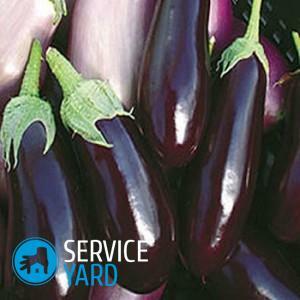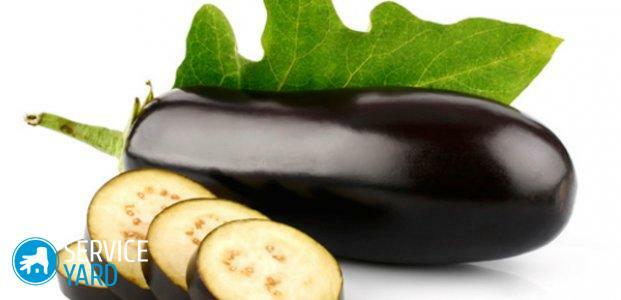
- Problem one: on the leaves of eggplant white spots
- Treatment methods
- Preventive measures
- What if there are white spots on the eggplant leaves?
- Problem two: seedlings do not grow
- Problem three: seedlings wither
- Problem four: yellow leaves lower
- Problem five: pests of
appear. Many gardeners, growing their eggplants on their site, know that this rather capricious vegetable requires special attention. Then the leaves turn yellow, the fruits do not tie, then the pests overpower, then white patches appear on the eggplant. Therefore, all those who decided to plant such a finicky culture, it is necessary to have an idea about the diseases of seedlings and vegetables, and also to know how to treat these diseases. Today, in the article, we will, with feeling and disposition, consider the causes of the most common problems associated with eggplant seedlings, and talk about possible ways to solve them.
to content ↑Problem one: on the aubergine leaves white spots
The reasons for the white spots on the leaves of the eggplant seedlings are varied. Plants can pick up the infection or be exposed to pests, and perhaps the gardener himself has forgotten how to properly care for a capricious vegetable. So first you need to find out the root cause and eliminate it, so as not to lose all the seedlings and the future harvest.
The main reasons for the appearance of white spots on eggplant leaves:
- Pests that feed on plant juice. Carefully inspect the reverse side of the sheet, there you will find the main pests that suck out the life-giving moisture from the leaves. From its lack and there are white spots on eggplant. The main enemies of this culture: whitefly, aphids, spider mites, fungal mosquitoes cyrids( in common - midge).
- Burns the sun or a hot object. A plant can get a burn from bright sun rays or from a lamp, which was highlighted by seedlings. As a result of such a burn, the leaf cells die and can not participate in photosynthesis.
Important! Put the lamp away from the plant, and protect the seedlings from the sun with tight tulle or newspapers, so that does not appear white spots on the eggplant .
- Superfluous top dressing or lack thereof. If the leaves begin to turn yellow at the edges and a brown fringe is formed, then this signals a lack of potassium. The metabolic disturbance leads to the death of the leaf, and everything begins with the appearance of white spots. In this case, fertilizing with potassium fertilizer or infusion of ashes( 1 tbsp. Ashes per 1 liter of water) will help. In the other case, if the seedlings are supplemented with mineral fertilizers( potassium-calcium nitrate) with excess, then on the eggplant leaves there may appear white spots. To neutralize the excess, pour the plants with a weak solution of potassium permanganate.
- Watering with cold water. The root system is not capable of absorbing cold water. The soil after such watering will be moist, but the leaves and stems will not receive water, and as a result - white spots and wilted leaves. It is imperative during the watering to ensure that the temperature of the watering water is not lower than 22-25 degrees.
Treatment methods
To combat white spots on eggplants, you can use the following methods:
- Prophylaxis. Preventive measures include proper care, which will eliminate the drying of the leaves.
- Treatment of seedlings. These are measures that must be taken to conserve seedlings if the problem has already appeared.
Let's consider in detail how to deal with the problem and what means to use, because it is easier to prevent changes in pigmentation on the leaves than to treat them.
Important! It should be remembered that it is no longer possible to restore damaged leaves to life, and the loss of at least a couple of leaf blades, at least, detains the development of young plants.
to the contents ↑Preventive measures
To avoid white spots appear on the eggplant leaves, it is necessary to create optimal conditions for the development and growth of the plant.
Preventive measures include:
- Proper care.
- Prophylactic treatment of seed.
- Treatment of young and adult plants by means against pests and diseases.

Selection of variety
Each summer resident knows that selecting the right plant variety is very important for the future harvest. In addition, it is always better to sow such varieties that are more resistant to diseases and pests. Therefore, we advise you to start your preventive measures with the correct selection of a variety of aubergines.
Experienced gardeners recommend the following varieties of vegetables:
- Epic F1 is a universal variety that can be grown both in the open ground and in a greenhouse.
- Black handsome - a popular early ripening variety. The fruits have the shape of a pear. This is the best variety for cooking caviar.
- Prime.
- Bebo F1 is an early-yielding aubergine variety with a white skin. Grow vegetables can be both outdoors, and in cold and warm greenhouses.
Important! Breeders have learned to obtain seeds with resistance to diseases and pests, but they can not program and monitor how you care for seeds grown from seeds. Therefore, even the right choice of variety does not guarantee that pigmentation does not appear on the leaves. After planting seeds - it all depends on the truck farmer.
Preparation of soil substrate
Everyone knows that in order to be healthy, you need to eat right. If a person does not eat properly, he often gets sick. In this respect, man is not much different from plants. It is dangerous for him both a lack and an excess of vitamins and minerals. So it is for seedlings: if there is little or too much vitamin-mineral substance in the substrate, pigmentation appears on the leaves.
To avoid this, listen to the following tips and prepare the soil as follows:
- Prepare a substrate from the following components: turf ground, humus, sand in a ratio of 4: 2: 1.
- Cook the ground in the oven for two hours for decontamination.
- Wait two weeks for useful bacteria to appear in the soil, and then sow the seeds.
Properly use fertilizers
If eggplant seedlings are cultivated on depleted soil, the cause of the disease and the appearance of pigmentation will be a lack of minerals. Therefore, as soon as the leaves on the plant appear, water the seedlings 1 time in two weeks with a solution of ammonium nitrate( 25 g of funds per bucket of water).Water the plants under the root without touching the leaves and stems. In the opposite case - they will burn, burned areas.
Important! Do not raise the concentration of the ammonium nitrate solution, since excess nitrogen provokes the appearance of on the leaves of eggplants of the white spots .
Proper watering
To prevent unwanted stains on eggplants, water the plants properly:
- Pour water into the jar.
- Place a jar of water next to the seedlings to ensure that the substrate and water are at the same temperature.
- Water the seedlings as needed.
- Do not overmoist the soil, otherwise - it will turn sour and will have a musty smell.
Important! In addition to the basic rules, it is necessary to take into account some of the tricks acquired with the experience of many gardeners:
- Water only then the seedlings, when you click a potty with your fingers you hear a sonorous sound. In this case, the earth wheel is withered. If the sound is deaf, then the soil is still wet and water it is not necessary.
- To prevent the from appearing white spots on the eggplant leaves from the sun, do not allow water to fall on them when watering. Otherwise, drops of water will play the role of a lens and a burn will be provided to the plant.
Proper lighting
Eggplants are very moody plants, they love:
- A long light day that should last 12 hours.
- Scattered light, that is not direct sunlight.

To provide optimal conditions for seedlings:
- Place trays with seedlings on the east or south window.
- Make sure that the plants have light from 8 am to 8 pm. If the light day is short, then use an LED lamp.
- Add an additional lamp at a height of 10 cm from the shoots.
- In time, raise the lamp as the bush grows, so that the light does not scorch the leaves.
What if there are white spots on the eggplant leaves?
If pigmentation has already appeared on the seedlings, then take urgent measures to conserve the plant. Use for treatment can be folk remedies or chemicals. Methods and means depend on the cause of the disease and the degree of infection.
Treatment of plants with folk remedies
To save the aubergine leaves, use the following folk recipes:
- 100 ml of whey, dilute in 1 liter of water( boiled and cooled).Spray the solution of the plant.
- Wood ash( 500 g) dilute in 1 liter of water. Put the solution on a fire and boil for 1 hour. Strain the solution and mix with 3 liters of cold boiled water. Treat the prepared solution with the leaves of the plant.
Important! If the cause of the appearance of pigmentation in excess of minerals after top dressing, then neutralize nitrogenous fertilizers with calcium nitrate or use chalk, dolomite flour. Egg shell, you can also use to neutralize nitrogen: calcify the shell and rastolkite in flour, and then add to the soil.
Treatment with chemical agents
Use the following tools to rid the leaf plates from white spots:
- Manganese solution. Pour plants with a weak solution of potassium permanganate.
- A mixture of citric acid and copper sulfate( 2 g of each ingredient per 3 liters of water).Treat affected leaves with a prepared solution.
- "Aktar".If the cause of the appearance of pigmentation in pests, then use a drug that protects them from parasites. Prepare the solution according to the instructions for the preparation.
Let's consider some more problems, which are very often encountered by summer residents.
to content ↑Problem two: seedlings do not grow
There can be several reasons for slow growth of plants:
- If the eggplants were transplanted from a common box to individual cups, the growth delay could be caused by root damage. To correct the situation, pour the plants solution of the drug "Kornevin."Prepare the slurry according to the instructions. Transplant young seedlings only with a clod of earth, or even better - immediately sow the seeds in separate boxes and pots, and do not perform a pick-up.
- If the growth delay occurred with growing seedlings, then carefully pull out one seedling along with a clod of earth, carefully examine the roots. If the roots are browned, then this indicates that the plant has little space and it requires a transplant into a large container. In this case, carefully transplant the seedlings into other pots with larger diameters( 2-3 cm larger than the previous ones).Add fertile land and special fertilizer "Signor tomato".
Problem three: seedlings wither
If the leaves fade only during the day in the sun, and in the morning they return to normal, then it's not scary. But if the plants wilt under normal watering and regardless of the weather, there may be several reasons, in particular:
- Excessive watering and soil wetting. In this case, move the seedlings in a larger diameter container and add ground. Go to small, but frequent watering.
- Screws. Because of the difference in temperature between the root and aboveground parts of the plant, the seedlings may wilt. This occurs when cold air is constantly flowing from the slots in the window frames or from the open window, and passes through the pots with roots, and at the top the leaves under the sun actively evaporate the moisture. Frozen roots do not keep up with the leaves and imbalance occurs. To correct the situation, raise pots with seedlings 15-20 centimeters higher.
- Lack of air for roots. Such a problem happens if the plants are tightly pressed together, and the ground is too tight. Loosen the top layer of the soil and, if necessary, expand the drainage holes.
- Subcooling. If the seedlings were taken out to the balcony for hardening, it could freeze and from the cold wither. In this case, pour the plants well with warm water( 30 degrees).
Problem four: yellow leaves lower
Plant seedlings are very voracious, and if there is not enough nutrients in the soil, the plant will continue its growth and development due to the lower leaves. As a result, the lower leaves become lighter, and then completely fly off.
Important! A similar phenomenon often occurs when growing seedlings on peat tablets or in a purchased peat soil.
To correct the situation, use top dressing with a complex mineral fertilizer.
to content ↑Problem five: pests of
appeared In the framework of pest control:
- Gently wipe the eggplant leaves with a solution of laundry soap.
- Spread the seedlings with "Aktara" or spray "Fitoverm".
Important! The appearance of pests is always an undesirable problem, but not everyone wants to saturate their crops with chemicals. With this approach, you can take the following useful tips:
- If you are not a supporter of the use of chemicals, get rid of harmful insects with the help of hot pepper. Sprinkle ground pepper and this will scare off the midge.
- Note the humidity in the room. Insects most often reproduce on wilted leaves, with a lack of humidity and irrigation. Try to spray the seedling daily with a very fine sprayer, directing it up and to the side, since the formation of drops on the leaves is unacceptable.
As you can see, you need to care for seedlings daily, because without you small bushes just die. They need your attention every day, as well as light, food, water and protection from pests and sun. But then, they will thank you with a rich harvest and you will be able to enjoy the amazing taste of baked, fried eggplants in the autumn and conservation from them in the winter.

